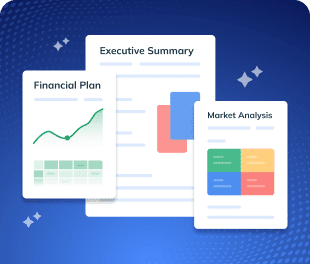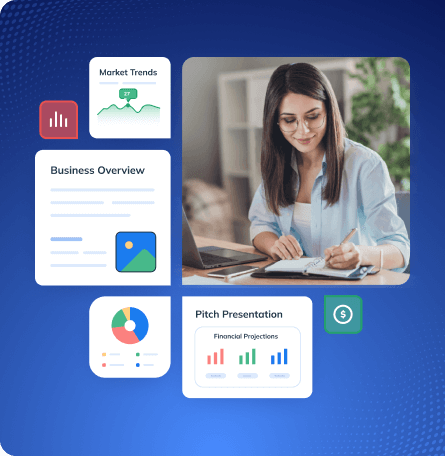Starting a water purification business? Great choice—clean water is something everyone needs, and you’re stepping into a meaningful, growing industry.
But turning your idea into a successful business takes more than good intentions.
You need a solid plan that keeps you focused, helps you make smart business decisions, and avoids costly mistakes.
In this guide, we’ll walk you through every step of creating a strong business plan. And to make things easier, we’re also sharing a free water purification business plan template to help you get started quickly and confidently.
What is a water purification business plan?
A water purification business plan is a written document that describes your water business’s goals and details how you’ll achieve them. It acts as a clear roadmap for your company.
It also covers key areas such as your products and services, target market, marketing strategy, daily operations, management structure, and financial projections.
In short, it’s the blueprint for how your water purification business will launch, operate successfully, and grow over time.
Why do you need a water purification business plan?
Beginning a water purification business may appear easy, yet you must have a solid plan to make your idea a successful venture.
Here’s why you need a business plan:
- Clarify your strategy: It explains what your business will do, what services you’ll offer, and how you’ll make money. This helps you stay on track and not lose sight of your goals.
- Understand your market: Planning involves researching your target market and competitors. You’ll identify who needs your services and what other solutions exist.
- Set goals and track progress: Writing a business plan helps you set clear targets and timelines, so you can measure growth and make smarter decisions as you go.
- Plan finances and secure funding: It includes budgets and forecasts to manage cash flow. If you’re seeking funding, it shows investors your business is well-planned and worth supporting.
In short, a clear business plan now can prevent costly mistakes later and give your water purification business a stronger chance of success.
What are the key components of a water purification business plan?
An effective water purification business plan should cover a number of key sections, starting from business description to financial forecasting.
Below, we break down each component and what to include in it. In covering all these sections, you’ll have a comprehensive, professional plan.
1. Executive Summary
The executive summary is the elevator pitch for your water purification business plan.
It’s a concise overview of your entire plan, typically one or two pages that give the reader a quick snapshot of your water purification company and why it will succeed.
Although this section comes first, it’s best to write it last, after you’ve worked out the details in other sections.
The following are the key components to include in your executive summary:
- Business concept
- Target market
- Unique selling proposition
- Financial outlook
- Funding needs (if any)
Ensure to keep it clear and compelling. Many people will only read the executive summary, so it should clearly explain what your business is and why it will work.
Say goodbye to boring templates
Build your business plan faster and easier with AI
Plans starting from $14/month
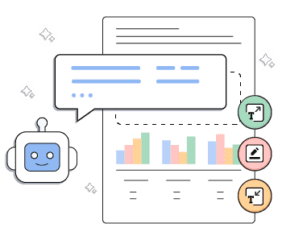
2. Business Overview
Now, it’s time to describe your water purification business in more detail.
The business overview provides foundational information—essentially the “who, what, and why” of your business. Think of it as the introduction to your company’s story.
Here’s what to include in your business overview section:
- Company basics: Mention your business name and where your purification facility or delivery service is located.
- Legal structure: Note your business legal structure—sole proprietorship, partnership, LLC, etc.
- Mission statement: Add a short, inspiring statement that captures your company’s purpose and values. For example: “To provide every home with clean, safe, and affordable drinking water.”
- Vision statement: Mention your long-term vision for the company. For example: “To become the leading purified water supplier in the region.”
- Goals: Outline both short-term and long-term goals, such as installing 100 home systems in the first year.
- Background & history: If your business has a backstory, briefly share it. Also, note what inspired you to start the venture.
By the end of the business overview, the reader should have a clear understanding of what your company is and aims to achieve. Keep it straightforward and factual.
3. Industry and Market Analysis
Before launching a water purification business, you need to understand the industry you’re operating in and the market demand for your services.
The market analysis section demonstrates your knowledge of the water purification industry, your target market, and the competitive landscape. Here’s what you should cover in this section:
Industry Overview
Start with the overall industry outlook. How big is the water purification market, and is it growing? Share a fact, like “the global water purifier market will grow from about $37 billion in 2025 to over $60 billion by 2032.”
Target Market
Who needs your water purification products and services most? Identify important key customer segments. For each segment, consider their needs and preferences. For example:
| Target Customer | Potential Needs |
|---|---|
| Households with poor tap water or old pipes | Home filtration units or delivered drinking water |
| Small businesses | Purified water for customers and employees |
| Industries | Ultra-pure water for industrial processes |
| Local government or communities | Water treatment kiosks or small plants for public use |
Market Gaps or Trends
Note about recent trends or market gaps happening in the water purifier industry. For instance:
- People are moving away from single-use plastic bottles, so refillable jugs are in demand.
- Many businesses want eco-friendly solutions, like in-house filtration systems.
Show how your business meets these needs.
Regulatory Environment
Mention any required permits or health certifications, like approval from the local health department for bottling water. Showing awareness of regulations convinces readers that you understand the industry landscape.
Overall, this section proves that you have a solid understanding of the market conditions. It builds confidence that your business isn’t operating in a vacuum—you’re launching based on research and real market needs.
4. Competitor Analysis
In any business, it’s important to know who your competitors are and how you’ll stand out.
The competitor analysis section shows that you understand the competitive landscape and have a plan to differentiate your company.
Start by listing direct competitors (like local water purification services) and indirect ones (like bottled water brands or filter kits in stores). Note what each does well and where they fall short.
Next, figure out your competitive advantage. How will you differentiate your water purification business? Why will customers choose you over the others? These things can help you stand out.
If possible, you can also perform a simple SWOT analysis of your business to identify the strengths, weaknesses, opportunities, and threats. For instance:
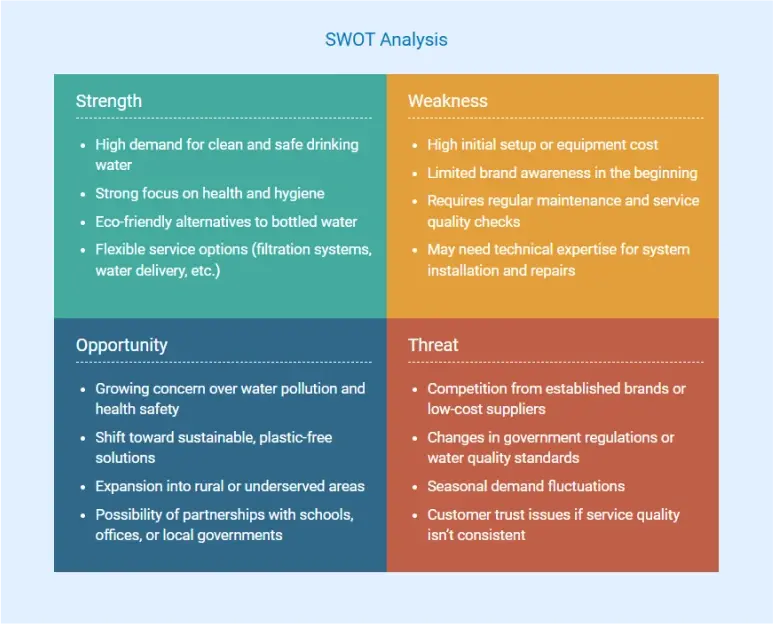
By the end of this section, it should be clear that you know your competition well and have found your spot in the market.
5. Products and Services
This section details what you’re selling and the services your water purification business will offer. It defines how you’ll generate revenue and deliver value to customers.
Start by listing what you’ll offer—like purification products, clean water supply, services, and related accessories—based on your business model. For each major product & service, describe it briefly and highlight how it benefits the customer.
Next, mention your pricing strategy or packages. Are you charging a one-time fee for installations? Do you have subscription plans? Keep it easy to understand.
| Product/Service | Description | Pricing |
|---|---|---|
| Home Water Purifier (Standard) | Basic RO+UV filtration system for household use | $150 – $250 (one-time) |
| Commercial Purification System | High-capacity system for offices or restaurants | $400 – $900 (one-time) |
| Installation Service | Setup and testing of purification system | $20 – $50 (one-time) |
| AMC (Annual Maintenance Contract) | 2–4 regular services per year, filter replacements | $50 – $100/year |
| Bottled Purified Water (5-Gallon Jug) | Ideal for homes and small offices | $6 – $10 per jug |
| Monthly Water Delivery (Subscription) | Includes 20 jugs/month + free delivery | $100 – $150/month |
| Water Testing Service | On-site water quality test with report | $10 – $20 |
| Replacement Filters/Accessories | Spare parts like filters, taps, containers, etc. | $5 – $30 |
If you offer anything special, like using a proprietary filtration technology or eco-friendly packaging, don’t forget to mention that. These things can set you apart. And if you plan to expand your services in the future, you can mention that too.
By detailing your products and services, the reader will understand exactly what you sell and how you fulfill a need.
6. Marketing and Sales Strategy
“Great, you have a wonderful product, but how will people know about it and buy it?” That’s what the marketing and sales strategy section answers. It outlines your plan to attract customers, make sales, and grow your revenue.
Marketing Strategies
Here are some channels and tactics you can use to reach your target customers.
Online presence: Make a simple website that highlights your services and allows inquiries or orders. Use social media platforms to share tips, customer testimonials, or before-and-after comparisons.
Local marketing: Distribute flyers or brochures in neighborhoods known to have water issues. Attend community events, health fairs, or environmental workshops to spread the word.
Partnerships: Partner with plumbing companies, real estate agents, or home builders. They could recommend your installation service to new homeowners.
Advertising and promotions: Offer any promotions to get initial customers, like a free water quality test or a first-month discount on water deliveries. Use traditional advertising to reach the older demographic, who aren’t on social media, but value clean water.
Sales Strategies
Explain how you’ll convert interested prospects into paying customers. You can:
- Offer a free consultation and water test
- Recommend a solution and provide a written estimate
- Follow up quickly to address questions and close the sale
Also, explain how you’ll keep customers happy and loyal.
Overall, this section shows you have a plan to attract, build trust, and keep customers coming back.
7. Management Team
Investors and partners often say they invest in people as much as in ideas. The management team section highlights who is running the company and why they’re capable of making the business succeed.
If you’re the founder, start by describing your qualifications. For example, maybe you studied environmental science or worked in a water treatment plant. Also, highlight any accomplishments that add credibility.
If you have additional team members, like a water treatment specialist, field technician, or marketing executive, introduce them. Provide their roles and responsibilities, educational qualifications, skills, as well as relevant industry experience.
You can also include a simple organizational chart to explain who reports to whom. For example:
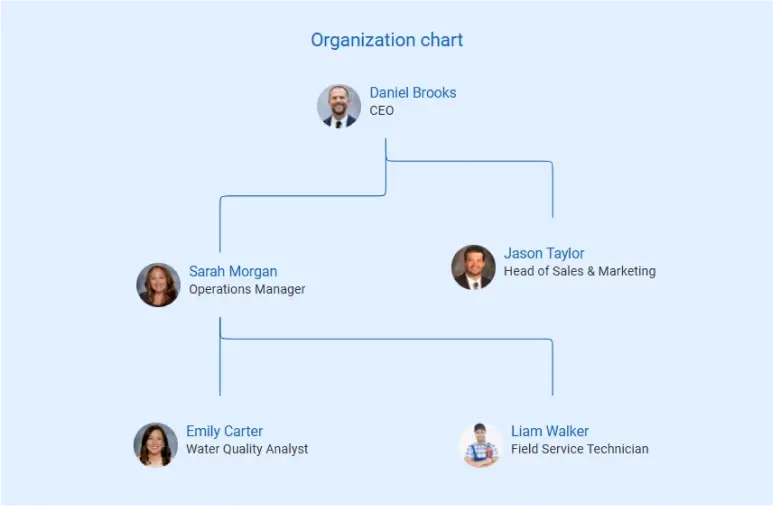
If applicable, also mention any values or work culture aspects that strengthen the team’s effectiveness.
In short, use this section to show that your team is skilled, dedicated, and ready to make the business successful.
8. Operations Plan
The operations plan explains the day-to-day setup of your business. Basically, how you’ll deliver your water purification products or services.
A well-thought-out operations plan shows that you have the systems and processes ready to run the business efficiently.
Here are the key points to consider in your operations plan:
- Facilities and location: Describe where you’ll operate your business. Do you have a water purification facility or a storefront?
- Equipment and technology: List the major equipment and tools required to run your business.
- Operational process: Walk through a typical service delivery process step by step to show how everything works in practice.
- Supply chain and suppliers: If you depend on other companies for equipment or materials, explain how you’ll manage that.
- Quality control: Explain how you’ll ensure your water is consistently pure and safe.
- Staffing and labor: Mention who will handle the operations. How many technicians or employees do you need for the daily activities?
- Inventory and logistics: Mention how you’ll manage inventory if you have physical products.
By covering these points, you show that your water purification business can run smoothly on a daily basis.
9. Financial Projections
The financial projections section explains how much money your business will need, spend, and earn. It helps show that your water purification business can be profitable and financially realistic.
Here’s how to create the financial projection for your water purification business:
Startup Costs
Start by outlining your expected one-time startup expenses. These can include:
- Purchasing filtration equipment
- Inventory of bottles/filters
- Facility lease deposits
- Vehicles for delivery
- Licenses and permits
Revenue Projections
Forecast your sales for the next 3-5 years. Your water purification business can make revenue from:
- Water deliveries
- Equipment sales/installations
- Maintenance services
This shows all the ways your business will bring in revenue.
Expenses Projections
Then, detail your expected expenses. Include fixed costs like rent, salaries, insurance, and loan repayments, as well as variable costs like filter replacements, water utility bills, fuel for delivery vehicles, bottle costs, etc.
The goal is to show that you understand your cost structure and have accounted for all necessary expenses.
Financial Statements
Now, provide an overview of your projected financials. This includes:
- Profit & loss statement
- Cash flow statement
- Balance sheet
From these, state your break-even point—when your revenues will cover all your expenses.
Funding Needs
If you’re seeking funding, say how much and what you’ll use it for.
It’s very helpful to include a visual chart showing how you’ll use the funds. For example:
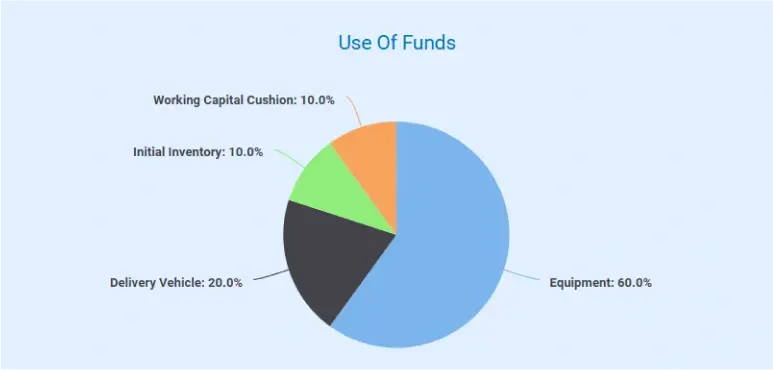
Visuals help show that you have a clear plan for using the money.
Overall, the financial plan section should show that your numbers make sense and that your business can be profitable.
Download a free water purification business plan template
Ready to write a water purification business plan, but need more help with that? We’ve got you covered. Download our free water purification business plan template in PDF to kick things off.
This investor-ready template has helped many water purification startups build clear, effective business plans. It’s pre-filled with example content and includes an outline of all the key sections we discussed above, so you can easily customize it to your needs.
The Quickest Way to turn a Business Idea into a Business Plan
Fill-in-the-blanks and automatic financials make it easy.
Conclusion
You now have a clear picture of how to build your water purification business, covering everything from your services and target market to strategy and financial planning. That’s a solid foundation to move forward with confidence.
Still need a bit of help? Upmetrics makes the process easier. With smart AI tools and ready-made templates, you can quickly write, format, and complete your plan without the stress.
So why wait? Start creating your water purification business plan the smart way today!
